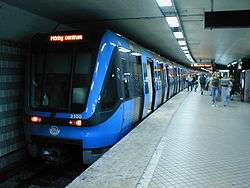Bombardier C20
| Bombardier C20 | |
|---|---|
|
A Bombardier C20 on the red line to Mörby centrum | |
|
Interior of a new C20 car | |
| In service | 1998–present |
| Manufacturer |
Kalmar Verkstad/Adtranz, Bombardier (only for C20F) |
| Built at | Kalmar, Sweden |
| Family name | Movia |
| Constructed | 1997–2004 |
| Number built | 270 vehicles (90 3-car sets) |
| Number in service | 270 vehicles (90 3-car sets) |
| Formation | 6 or 9 cars per trainset |
| Fleet numbers |
2000 (C20F) 2001–2270 |
| Capacity |
(in 3-car formation) 126 seating 288 standing (323 standing for C20F) |
| Operator(s) | MTR Corporation (under contract from Storstockholms Lokaltrafik) |
| Depot(s) | Hammarby, Högdalen, Nyboda, Rissne, Vällingby |
| Line(s) served | All Stockholm metro lines |
| Specifications | |
| Car length | 46.5 m (152.56 ft) |
| Width | 2.9 m (2,900 mm) |
| Height | 12.08 ft (3,682 mm) |
| Platform height | 3.76 ft (1.15 m) |
| Doors |
2 pairs per side for front/back cars 3 pairs per side for middle car |
| Maximum speed |
70 km/h (43 mph) (Green Line) 80 km/h (50 mph) (Red and Blue Lines) 90 km/h (56 mph) (Design speed) |
| Weight |
91,000 lb (41,277 kg) (A car) 86,670 lb (39,313 kg) (B car) |
| Electric system(s) | Electric AC, Third rail |
| Current collection method | Contact shoe |
| UIC classification | Bo'Bo'Bo'Bo' |
| Safety system(s) | ATC (ATO) |
| Track gauge | 1,435 mm (4 ft 8 1⁄2 in) |
The Bombardier C20 is a type of subway train used in the Stockholm Metro, Sweden. Between 1997 and 2004, 270 cars were delivered to Stockholm (No. 2001 to 2270) by the former Kalmar Verkstad, owned by Adtranz, later acquired by Bombardier Transportation. The C20 is a completely new design and therefore is not compatible with other train types in the system. At 46.5 metres (153 ft), each carriage is longer than the previous train types. To save cost and weight, each unit has only four bogies. The middle car has two bogies. The end parts consist of one bogie each and are connected to the central portion via a semi-trailer-direction. Trolley subframes are made of stainless steel, and are less susceptible to corrosion.
When the C20 was sold as the Vagn 2000 (English: Wagon 2000), it was marketed as the subway car of the future. All C20 coaches have been given their own names, all proposed by private individuals. Many of the names are linked to Stockholm; for example, coach no. 2001 was christened Birger Jarl.
C20F
The C20F is a related prototype, built with "FICAS" technology – a highly innovative modular construction that uses a stainless steel skin bonded to a rigid composite core. This construction results in an extremely thin wall (25mm instead of the 100mm in a C20), thereby creating a more spacious interior without altering the outer profile.
The C20F has air conditioning in both the driver's cab and the passenger compartments, whereas the C20 has air conditioning in the driver's cab only. The exterior of the C20F differs by having smooth trolley sub-frames instead of the corrugated trolley sub-frames present in the C20.
The C20F car assigned the carriage no. 2000 and originally christened Incognito. On 22 May 2012, the C20 carriage no. 2012, previously named Elvira, was renamed the Estelle on the occasion of Princess Estelle's baptism.[1] The C20F was then renamed Elvira, and currently no car is named Incognito.
The C20F operates on the Green Line of the Stockholm metro.
-

A C20F train at Enskede gård metro station
-

Interior of a C20F car
